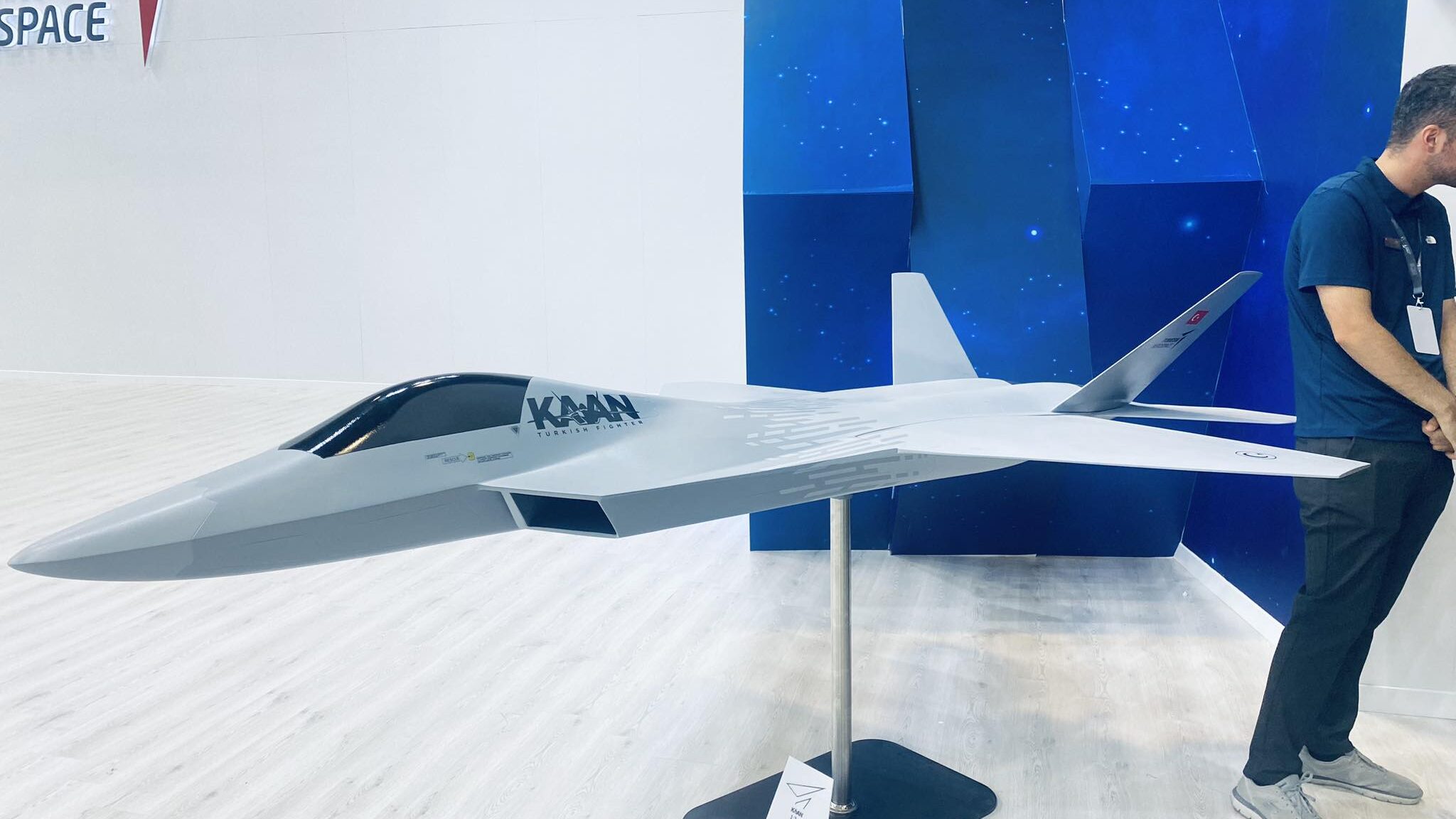AGNES HELOU

A model of Turkey’s fifth generation fighter jet KAAN, at IDEF 2023 in Istanbul. (Agnes Helou / Breaking Defense)
BEIRUT — Just a week after Turkey signed an agreement to add Azerbaijan to its fifth generation fighter jet program, a senior Turkish official suggested that Pakistan, too, could join in.
“Pretty soon, within this month, we will be discussing with our Pakistani counterparts to officially include Pakistan in our national fighter jet program, KAAN,” deputy defense minister Celal Sami Tufekci announced Wednesday.
The agreement with Azerbaijan came last week during the International Defense Industry Fair, or IDEF 2023, held in Istanbul. It was a move that was described by Turkish president Recep Tayyip Erdogan as a “new sign of solidarity between the two countries.”
While the Pakistani government doesn’t appear to have commented publicly about their potential inclusion, and a representative for the Pakistani air force did not immediately respond to Breaking Defense’s request for comment, experts said that working with other countries will accelerate the development process for the ambitious KAAN project and with reduce the risks on Turkey.
“Developing a fifth-generation fighter aircraft is a complex and costly endeavor that requires a wide range of expertise and resources. Collaborating with other countries allows Turkey to pool resources and technological know-how from the participating nations and distribute the financial burden, resulting in a more advanced and capable aircraft,” Mohammed Soliman, director of the Strategic Technologies and Cyber Security Program at the Middle East Institute, said.
Turkey has revealed an ambitious schedule for the fighter, including a first flight scheduled for late December, though experts said it could be a decade or more before the plane is operational.
“We have a period of [10-plus] years ahead of us, and there is no guarantee that this process will end smoothly and on time,” Turkish aerospace and defense expert Cem Dogut told Breaking Defense.
Soliman, too, said the timeline seemed “challenging.”
“Integrating various technologies, ensuring safety, conducting thorough testing, and obtaining necessary certifications are time-consuming processes. While Turkey’s timeline is ambitious, such projects are not uncommon to experience delays due to unforeseen technical or logistical challenges,” he said.
According to Dogut, assembly for the first KAAN prototype began in April 2022, and it was unveiled in January 2023 to defense figures and the media. He added that the prototype performed its first engine run-up test with F110-GE-129E Turbofan Engines on Feb. 21, 2023. In May 2023 Turkey named the plane KAAN, and Erdogan himself hopped in the cockpit for a photo op.

President Recep Tayyip Erdoğan at the presentation ceremony of the National Combat Aircraft KAAN on May 1, 2023 in Ankara, Türkiye. (Photo by Yavuz Ozden/ dia images via Getty Images )
Each KC-46A will take about two months to retrofit with a new vision system, according to the Air Force’s program lead, a fix that will address two of six remaining critical defects in Boeing’s Pegasus air refueling tanker.
“The CDR [critical design review] phase of KAAN has not been completed yet. There will be quite a difference between the [prototype plane], which will make its maiden flight by the end of the year, and the Block 10, which will enter mass production,” Dogut said.
He highlighted that since the development phase of KAAN, whose design has not been finalized yet, the support of the countries that will join the project is still important. Dogut stressed that the program has a long process ahead of it and Turkey needs all kinds of cooperation and support.
Azerbaijan’s contribution to the aircraft production could include financial investment and potential industrial collaboration, he said.
Solimane said if Pakistan “joins the program, it could bring its own resources, technology, and manufacturing capabilities.”
Dogut also said that Turkey has a different relationship with Azerbaijan and Pakistan than many other countries.
“They are seen as brother countries rather than friends and allies. The perspective of both countries towards Turkey is similar to Turkey’s. Azerbaijan’s main contribution will be to help support the project financially. Pakistan will support the production and development part of the business,” Dogut said.
He added that unlike Azerbaijan, Pakistan has production and development experience in aviation.
One potential drawback of drawing Pakistan in to the program, Dogut said, was Islamabad’s close relationship to China, which could create an “information security risk” for the KAAN project and potentially limit the use of parts from hesitant Western producers.
F-16 Quest Alive And Well
The development of the KAAN fighter, primarily by Turkish Aerospace Industries, would presumably lighten the burden of having to procure foreign fighters, like Turkey’s long pursuit of upgraded F-16 fighters from the US.
But Dogut said the KAAN is unlikely to change those plans anytime soon, as the fighter isn’t expected to be ready for combat until the mid-2030s at least, and won’t be cheap — potentially up to $14 billion.
He added that increasing the capability of the existing F-16 fleet — with the Viper modernization with the US or the national Ozgur modernization project — and the purchase of additional aircraft will always be on the table until the KAAN is operational. After KAAN wins IOC/FOC, existing F-16s will remain in service for many years.
“It will take decades for KAAN to be produced and… to serve in fleets,” Dogut commented.
In his opinion, Soliman considered that Turkey’s decision to phase out other aircraft like the F-16 after the KAAN becomes operational depends on various factors.
“The F-16 has different roles and capabilities than a fifth-generation aircraft like the KAAN. Operational needs, strategic considerations, and military interoperability with the US and NATO alliance will likely influence the decision. Turkey might continue to utilize a mix of aircraft to fulfill different roles within its defense strategy even after the KAAN becomes operational,” he concluded.
No comments:
Post a Comment